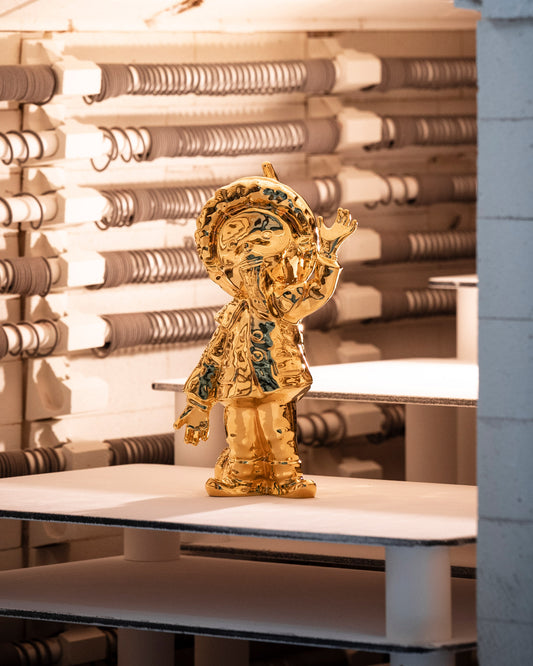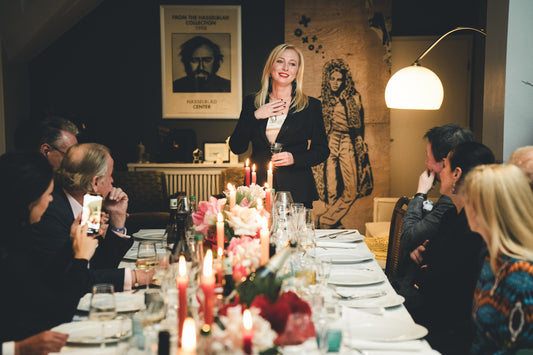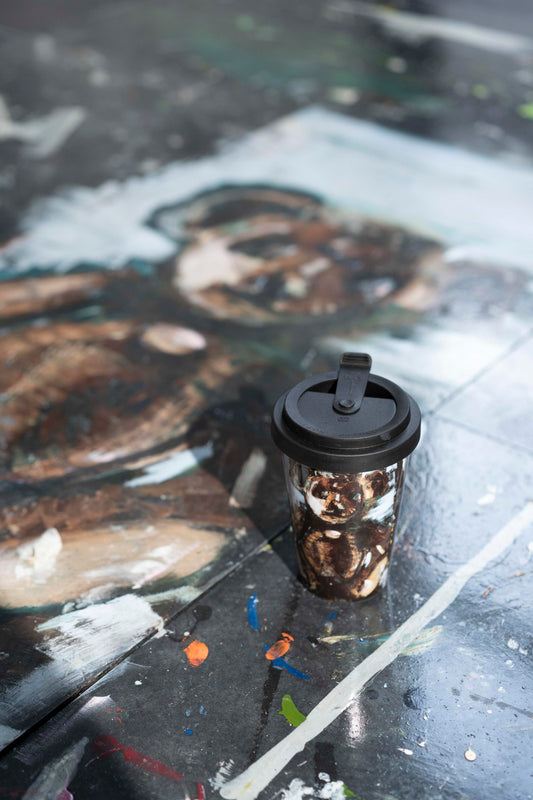WOLTMANN MEETS HOUSE FRIENDS ALICE & KILIAN JAY VON SELDENECK
Alice & Kilian Jay von Seldeneck buy and auction porcelain with great passion. Jörg Woltmann, owner of KPM Berlin, spoke for our WEISS Magazine No. 5 with the couple about things that tell stories and works of art in children's hands...
JÖRG WOLTMANN: How did you come to collect porcelain? This is rather unusual for a young couple like you.
ALICE VON SELDENECK: I think as a collector you should always buy what you enjoy. If someone only buys something because they think it is a good investment, they are collecting incorrectly.
KILIAN VON SELDENECK: There's a nice term: In addition to the monetary return that you expect, there is also an emotional return. If you walk past a collectible every day and enjoy it, that's priceless.
JÖRG WOLTMANN: What excites you about the KPM Berlin properties?
KILIAN VON SELDENECK: I find the design language that was developed in this Berlin factory very exciting. The grand masters of the respective eras were able to try their hand at porcelain here.
ALICE VON SELDENECK: What we concentrate on when collecting are the porcelains of the 20th century. During this time, many artists in the KPM inspired each other. In my opinion, the classic forms of Trude Petri, Siegmund Schütz, Enzo Mari and Marguerite Friedlaender still have a lot of potential. Interest in it is increasing.
JÖRG WOLTMANN: This era is also the focus of a publication that I supported with my foundation. In the three-volume work “Porcelain of the KPM Berlin 1918–1988”, the author Tim Gronert devotes himself to modern Berlin porcelain production .
ALICE VON SELDENECK: Tim Gronert's publication was a highlight of 2020 for me. One volume is solely about the artists who worked for the KPM. I think it's great that a young man has immersed himself in this topic for ten years and, as the son of an antique dealer, has brought in a lot of family knowledge.
JÖRG WOLTMANN: Until I took over the factory, I was only a user of KPM porcelain. I bought my first KURLAND service when I was 28 and still have it. Today – as a lover and collector – I of course also have the classics such as the PRINCESS GROUP, the SCHINKELKORB and the FRIEDRICH bust. Each is a complicated masterpiece and very fragile in the manufacturing process. Do you have a favorite piece from our factory?
KILIAN VON SELDENECK: We recently bought a FLOWER BOAT from Siegmund Schütz, in a very special 1950s paint job: black on one side, yellow on the inside and white on the outside.
ALICE VON SELDENECK: It has a porcelain insert that I fill with new flowers every week. It looks different every time. It's actually a work of art. KILIAN VON SELDENECK: The whole table is beautifully decorated with it and at the same time it allows a conversation to take place over the flowers. Sometimes a vase gets in the way.
JÖRG WOLTMANN: You have four children... Are your KPM dishes also used or are they in the display case?
KILIAN VON SELDENECK: We have four children – our eldest son just turned ten – and a dog. Nevertheless, we still serve good dishes on the table.
ALICE VON SELDENECK: Yes, that is important to me. I want to get the children used to beautiful things from an early age.
JÖRG WOLTMANN: In my parents' house we only ate good KPM dishes on Sundays. And I knew early on that it was something special. My brother and I didn't have to set and clear the table, and we weren't allowed to wash up and dry ourselves. That was too dangerous for good service. That was fine with us, we especially hated doing the dishes.
KILIAN VON SELDENECK: Our children grow up with KPM and have a feeling for this material, which has exuded magic since 1763 and continues to fascinate people today. They have no fear of contact.
ALICE VON SELDENECK: On the contrary. Something really great happened recently. I bought two different tea sets from KPM in Hamburg, but both in the same design. The opportunity was just too tempting. When I received the large box with the two services and unpacked it, my five-year-old son was there. He took two cups, turned them over and said: “Mommy, look, they look the same, but one has an orb on it. One is from before the war, the other from after.”
JÖRG WOLTMANN: He recognized it from the label under the cups?
ALICE VON SELDENECK: Yes. The mere fact that he knew the term imperial orb surprised me. I asked him: “How do you know that?” “Daddy once told me,” was his answer.
JÖRG WOLTMANN: As the daughter of Henrik Hanstein, the fifth generation to run the Lempertz art auction house in Cologne, you also grew up surrounded by precious objects. Were you aware of this as a child?
ALICE VON SELDENECK: Of course I wasn't aware of it as a child, but it certainly didn't leave me completely unscathed. My parents definitely gave me a sense of beautiful things.
JÖRG WOLTMANN: If you look at the market today: Would you advise someone to collect porcelain?
KILIAN VON SELDENECK: If you are a young, aspiring collector and have a budget of - let's say - 5,000 or 10,000 euros, you will only get one edition by Gerhard Richter. But you can definitely buy an exciting piece from the KPM that cannot be ignored from the canon of art history.
ALICE VON SELDENECK: And this piece retains its value. For example, if you keep a KPM mug long enough, you can actually earn a lot of money from it. Admittedly, it takes time. What we are selling at a high price now is 18th century porcelain. You can't wait 250 years... But you could pass it on. Or sell it again after a week at a good price.
JÖRG WOLTMANN: People might generally think that porcelain isn't really in vogue.
KILIAN VON SELDENECK: I have the feeling that porcelain is a collecting area that already has a lot of dynamism. We have many friends who are passionate about porcelain. There are these so-called conversation pieces: conversation pieces that are bought to tell stories and history. And with the old techniques that the KPM is now reviving, they bridge the gap between generations.
JÖRG WOLTMANN: What do you particularly like?
ALICE VON SELDENECK: The chandelier painting on the BERLIN breakfast cups, for example. These are magnificent guest gifts - a modern design and at the same time deeply rooted in KPM history thanks to the chandelier painting.
Woltmann meets family friends Alice & Kilian Jay von Seldeneck


